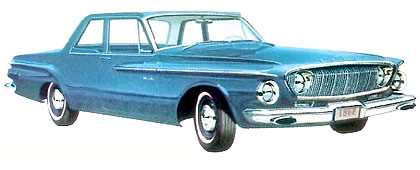If you look at the 1962 Dodge Dart, it looks like the car that couldn’t make up its mind up about what it wanted to be when it rolled off the assembly line. Let’s see, it had one set headlights fared into the grille about four inches higher than the outer headlights. The bright grille featured vertical bars. The grille was rimmed by a chrome oval. The headlight look, itself, created quite a stir, but not at much as the two wings (what else could you call them) that sprouted about two inches below the mid-level beltline of the Dart. You certainly couldn’t call that your usual body styling, could you? It was as if one team of designers was let loose to design a fender; a second to design the other fender, and a third to design the headlights.
 To say that front end was weird-looking wasn’t the half of it because the rear was the same. A similar set of wings sprouted at the wheel wells and then swept upward to a set of circular taillights that dominated the rear end of the quarter which then swooped down to join the trunkline. The styling left many people shaking their heads and wondering where Dodge was headed with the Dart.
To say that front end was weird-looking wasn’t the half of it because the rear was the same. A similar set of wings sprouted at the wheel wells and then swept upward to a set of circular taillights that dominated the rear end of the quarter which then swooped down to join the trunkline. The styling left many people shaking their heads and wondering where Dodge was headed with the Dart.
At this time, you see, the Dart was not the compact that it came to be in the late 1960s. It was still what we would term a full-sized car in a stable of full-sized cars. The overall effect of the Dart reminds one of a “clown car,” the kind you find in circuses around the world where 42 clowns seem to tumble from this weird-looking little machine that can barely get out of its own way.
That wasn’t true of the 62 Dart, though, because its full-name was the Dart 413 or the Dart Wedge 413. Hiding underneath all of that unusual body armor was Dodge’s 413-cubic-inch Wedge engine, the pre-hemi monster that turned out 375 horsepower in normal trim. (The reason the Wedge bore that name was because of the wedge-shaped combustion chambers – the forerunner of the famed hemi.)
In its normal trim, the 1962 Dodge Dart could turn a reasonable quarter mile in the upper 14s with an exit speed in the 90s, which was pretty good for the boss, stock engine, but if you wanted to do anything more than drive in a straight line then you had a real handful, even with the standard powertrain, on your hands. Not only was the handling more than a little numb, but when you headed into a corner – unless you used some good performance tuning – you had a car that suffered from two common maladies of the era, terminal brake fade – the brakes heated up too much and wouldn’t stop the car very quickly (unless there was some kind of barrier in front) and the Dart, even though it was a rear-drive vehicle, still suffered from terminal understeer because the designers wanted to make sure that owners were ensconced in a luxury ride.
Imagine taking this up to a whole new dimension with a MaxWedge 413 that had an 11:1 compression radio and could crank out 410 horsepower and 460 pounds-feet of torque — enough to rip a few stumps out of the ground – but when you tweaked the engine out to its max at 13.5 to 1 compression, and which delivered 420 horsepower and 470 pounds feet of torque – you had a package that could turn 14-second quarter miles and exit speeds of 100 or more all day long. By the way, the connectors were magnafluxed and they used a double-breaker ignition system. Two Carter four barrels rounded out this performance monster.
It’s just too bad that the body had to be so weird-looking, although the engine might have had something to do with the actual design choice because factory-installed 3-inch headers were used on the sides of the engine and swept up toward the rear.
The 1962 Dart, for all its quirkiness, also quietly marked the move of Chrysler Corp. from the “full-size” performance vehicles everyone had assumed it would always produce (122-inch-wheelbase Imperial-style behemoths) to a more “intermediate-sized” 116-inch wheelbase and they did lighten the load that the powerteam had to push (a three-speed manual and a pushbutton Torque-Flite automatic) to about 3,200 pounds, which was quite an achievement in that bloated era.
